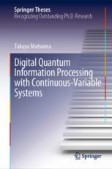Search
Search Results
-
Quantum Protocols for Private Set Intersection Cardinality and Union Cardinality Based on Entanglement Swap**
Quantum private set intersection cardinality (PSI-CA) and private set union cardinality (PSU-CA) are two specific primitives of classical secure...

-
A Secure Quantum Private Set Computation Protocol with Identity Authentication Utilizing GHZ States
Private set computation (PSC) represents a pivotal technology in the information age, facilitating the processing of sensitive datasets while...

-
A novel quantum private set intersection scheme with a semi-honest third party
In this paper, we propose a novel scheme with a semi-honest third party (TP) to compute the intersection of two parties’ sets privately. In our...
-
A Novel Quantum Protocol for Private Set Intersection
Private set intersection(PSI) allows two parties to get all common elements of their private sets without leaking any information about their sets....
-
Quantum private computation of cardinality of set intersection and union
AbstractPrivate Set Intersection Cardinality (PSI-CA) and Private Set Union Cardinality (PSU-CA) are cryptographic tasks whose goals are to compute...

-
A quantum protocol for private substitution problem
Private substitution (PS) is a problem for replacing one party’s binary string with the other party’s binary string in a privacy preserving manner....

-
Implementation of quantum measurements using classical resources and only a single ancillary qubit
We propose a scheme to implement general quantum measurements, also known as Positive Operator Valued Measures (POVMs) in dimension d using only...

-
Quantum secure two-party computation for set intersection with rational players
Recently, Shi et al. (Phys Rev A 92:022309,
2015 ) proposed quantum oblivious set member decision protocol where two legitimate parties, namely Alice...
-
Properties of the contraction map for holographic entanglement entropy inequalities
We present a deterministic way of finding contraction maps for candidate holographic entanglement entropy inequalities modulo choices due to actual...
-
Quantum solution to a class of two-party private summation problems
In this paper, we define a class of special two-party private summation (S2PPS) problems and present a common quantum solution to S2PPS problems....
-
Singularity of the Spectrum for Smooth Area-Preserving Flows in Genus Two and Translation Surfaces Well Approximated by Cylinders
We consider smooth flows preserving a smooth invariant measure, or, equivalently, locally Hamiltonian flows on compact orientable surfaces and show...

-
Trading Locality for Time: Certifiable Randomness from Low-Depth Circuits
The generation of certifiable randomness is the most fundamental information-theoretic task that meaningfully separates quantum devices from their...

-
Universal random codes: capacity regions of the compound quantum multiple-access channel with one classical and one quantum sender
We consider the compound memoryless quantum multiple-access channel (QMAC) with two sending terminals. In this model, the transmission is governed by...
-
Quantum Key Distribution with Continuous-Variable Systems
Continuous-variable quantum key distribution has affinity to the optical telecommunication, and thus has advantages in the real-world implementation....
-
Entanglement entropies of an interval in the free Schrödinger field theory at finite density
We study the entanglement entropies of an interval on the infinite line in the free fermionic spinless Schrödinger field theory at finite density and...
-
A Conditional Curie–Weiss Model for Stylized Multi-group Binary Choice with Social Interaction
This paper proposes a conditional Curie–Weiss model as a model for decision making in a stylized society made up of binary decision makers that face...

-
Exact moments of the Sachdev-Ye-Kitaev model up to order 1/N2
We analytically evaluate the moments of the spectral density of the q -body Sachdev-Ye-Kitaev (SYK) model, and obtain order 1 /N 2 corrections for all...
-
Category Theory and Quantum Mechanics
In the present chapter, we shall deal with the general logical–epistemological foundations of the quantum theory, where the stress is on...
-
On 2-form gauge models of topological phases
We explore 2-form topological gauge theories in (3+1)d. These theories can be constructed as sigma models with target space the second classifying...
